
Website owner: James Miller
Point sets in one, two, three and n-dimensional Euclidean spaces. Intervals, neighborhoods, closed sets, open sets, limit points, isolated points. Interior, exterior and boundary points. Derived set. Closure of a set. Perfect set. Arcwise connected sets. Regions. Coverings. Theorems. Bounded, compact sets.
Def. Point set. A set whose elements are points. The points may be points in one, two, three or n-dimensional space.
Examples of various types of point sets

1. The closed interval [a, b] on the
x-axis corresponding to a
![]() x
x
![]() b
is a point set in one-dimensional
space that consists of points a, b
and all points in between.
b
is a point set in one-dimensional
space that consists of points a, b
and all points in between.
2. The open interval (a, b) on the x-axis corresponding to a < x < b is a point set in one-dimensional space that consists of all points between a and b (but not a and b themselves).

3. Figure 1 shows a set A of points in one-dimensional space — an open interval, half open / closed interval, closed interval and two isolated points.
4. The points satisfying the equation
x2 + y2 < 25
represent a point set in two-dimensional space consisting of all points interior to the circle x2 + y2 = 25 i.e. an open disk of radius 5 centered at the origin. See Fig. 2. . The dashed line in the figure indicates that the boundary is not included in the point set.
5. The points satisfying the equations

5
![]() x
x
![]() 7
7
2
![]() y
y
![]() 3
3
represent a point set in two-dimensional space consisting of all points in the indicated rectangular region. See Fig. 3.
6. Figure 4 shows a set E of points in two dimensional space. E consists of all points shown in blue. Dashed lines indicate sections of boundary not included in E.
7. The points satisfying the equation
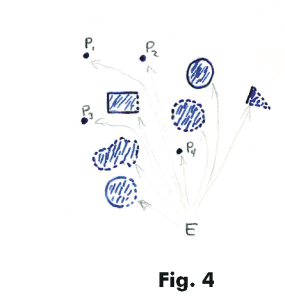
x2 + y2 + z2 < 25
represent a point set in three-dimensional space consisting of all points interior to the sphere x2 + y2 + z2 = 25 i.e. an open sphere of radius 5 centered at the origin.
8. The points satisfying the equations
5
![]() x
x
![]() 7
7
2
![]() y
y
![]() 3
3
8
![]() z
z
![]() 9
9
represent a point set in three-dimensional space consisting of all points in the specified rectangular region.
9. The points satisfying the equations
a1
![]() x1
x1
![]() b1
b1
a2
![]() x2
x2
![]() b2
b2
.........................
an
![]() xn
xn
![]() bn
bn
represent a point set in n-dimensional space consisting of all points in the specified rectangular region.
10. The points satisfying the equation
|x-a| < r
represent a point set in n-dimensional space consisting of all points inside an open sphere of radius r where x and a are vectors in n-dimensional space and r is a positive number.
N-dimensional Euclidean space. The space defined by the Cartesian product Rn =
R
![]() R
R
![]() R
R
![]()
![]()
![]() R (n times) is called n dimensional Euclidean space. A point in this space is
an ordered n-tuple (x1, x2, ..... , xn) of real numbers.
R (n times) is called n dimensional Euclidean space. A point in this space is
an ordered n-tuple (x1, x2, ..... , xn) of real numbers.
Distance in n-dimensional Euclidean space. If x = (x1, x2, ..... , xn) and y = (y1, y2, ..... , yn) the distance between x and y is defined as
![]()
Open sphere. The set of points {x: d(x, y) < r) is called an open sphere of radius r with center at y. It is also sometimes called a spherical neighborhood of y.
Closed sphere. The set of points {x: d(x, y)
![]() r) is called an closed sphere of radius r with
center at y.
r) is called an closed sphere of radius r with
center at y.
If n = 1 the open or closed sphere reduces to an open or closed interval respectively. If n = 2 the open sphere becomes the interior of an open circle in the plane and a closed sphere becomes the interior of a closed circle in the plane. If n = 3 the open and closed spheres correspond to open and closed spheres in three dimensional space.
Intervals in n-dimensional space. The concept of an open or closed interval, (a, b) or [a, b], on the real line has been generalized for two, three and n-dimensional space.
Open interval. In 2-space an open interval is the rectangular area consisting of all points (x1, x2) satisfying
a1 < x1 < b1
a2 < x2 < b2
where a1, b1, a2, b2 are fixed constants. In 3-space it is the rectangular parallelepiped consisting of all points (x1, x2, x3) satisfying
a1 < x1 < b1
a2 < x2 < b2
a3 < x3 < b3
and in n-space it is the “generalized rectangular parallelepiped” consisting of all points (x1, x2, ....., xn) satisfying
a1 < x1 < b1
a2 < x2 < b2
..................
..................
an < xn < bn
for fixed constants ai, bi, i = 1, 2, ..... , n.
Closed interval. Closed intervals are defined in a similar fashion. A closed interval in n-space is the “generalized rectangular parallelepiped” consisting of all points (x1, x2, ....., xn) satisfying
a1
![]() x1
x1
![]() b1
b1
a2
![]() x2
x2
![]() b2
b2
..................
..................
an
![]() xn
xn
![]() bn
bn

for fixed constants ai, bi, i = 1, 2, ..... , n.
Def. ε-neighborhood. The ε-neighborhood of a point P in a one, two, three or n-dimensional space is the set of all points whose distance from P is less than ε. Thus the ε-neighborhood of a point a in n-space is the set of x satisfying |x-a| < ε where x and a are n-vectors and ε is any specified positive number. The ε-neighborhood of a point a is also called the “ε-spherical neighborhood of a” or the “ε-open sphere of a”.
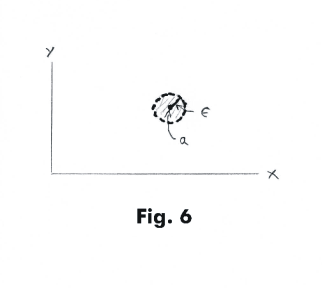
Distance in n-space is given by a formula analogous to the one for 3-space. If x = (x1, x2, ... xn) and y = (y1, y2, ... yn) represent two points in n-space the distance ρ between them is defined as

In the case of one-dimensional space the ε-neighborhood of a point a corresponds to an open interval on the x-axis extending out to a distance of ε on either side of a. See Fig. 5. In the case of two-dimensional space the ε-neighborhood of a point a corresponds to the interior of a circle centered at a with radius ε. See Fig. 6. In the case of three-dimensional space the ε-neighborhood of a point a corresponds to the interior of a sphere centered at point a with radius ε.
Def. ε-deleted neighborhood. The ε-deleted neighborhood of a point P in a one, two, three or n-dimensional space is the ε- neighborhood of the point P minus the point P itself. Thus for a point a in n-space the ε-deleted neighborhood of a is given by all points x satisfying 0 < |x-a| < ε. The ε-deleted neighborhood of a point is also called the “deleted ε-spherical neighborhood” of the point.
Def. Interior point of a point set. Let S be a point set in one, two, three or n-dimensional space. A point P is called an interior point of S if there exists some ε-neighborhood of P that is wholly contained in S.
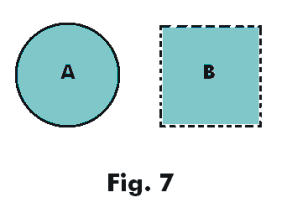
Example. The interior points of figures A and B in Fig. 7 are all points within the figures but not including the boundaries.
Def. Interior of a point set. The interior of a point set S is the subset consisting of all interior points of S and is denoted by Int (S).
Def. Boundary point of a point set. A point P is called a boundary point of a point set S if every ε-neighborhood of P contains points belonging to S and points not belonging to S.
Example. Points on the boundaries of figures A and B in Fig. 7 are boundary points.
Def. Boundary of a point set. The set of all boundary points of the point set.
Def. Exterior point of a point set. A point P is an exterior point of a point set S if it has
some ε-neighborhood with no points in common with S i.e. a ε-neighborhood that lies wholly in
![]() , the complement of S. If a point is neither an interior point nor a boundary point of S it is an
exterior point of S.
, the complement of S. If a point is neither an interior point nor a boundary point of S it is an
exterior point of S.
Example. Points outside the boundaries of figures A and B in Fig. 7 are exterior points.
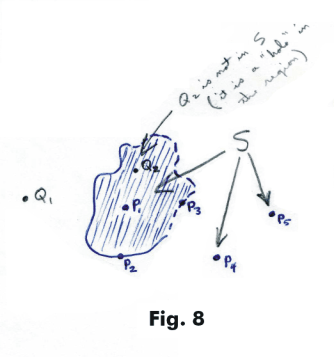
Def. Exterior of a point set. The set of all exterior points of the point set.
Example. Figure 8 shows a point set S in the plane. S consists of points in the enclosed area plus points P4 and P5. Point Q2 represents a “hole” in the enclosed area, a missing point, a point not in S. The dashed line on the boundary indicates that the boundary in that area is not included in S. Q1 is an arbitrary point outside of S. Using the definitions above we find that point Q1 is an exterior point, P1 is an interior point, and points P2, P3, P4, P5 and Q2 are all boundary points.
Def. Limit point. A point P is called a limit point of a point set S if every ε-deleted neighborhood of P contains points of S.
Syn. Accumulation point, cluster point.
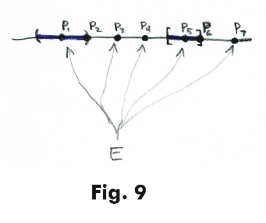
Examples.
1. All points interior to and on the borders of figures A and B in Fig. 7 are limit points (or accumulation points or cluster points).
2. Consider the point set S of Fig. 8. Using this definition, we find that points P1, P2, P3 and Q2 are limit points. P4, P5 and Q1 are not.
3. Consider the point set E shown in Fig. 9. Points P1, P2, P5 and P6 are limit points. Points P3, P4 and P7 are not.
4. Consider the set of points E
![]()
In this set every point is an isolated point. The point 0 is a limit point of E (and does not belong to it). All other points on the line are exterior to it. It is in this example that one sees the motivation for the terms “limit point”, “accumulation point” and “cluster point”. It was in the study of infinite sequences of this type that the terms originally arose.
5. Let set Q consist of all the rational points of the interval [0, 1]. This set contains no isolated points. All of the points in the interval (both the rational points and the irrational points that are scattered in between the rationals) are limit points. All points outside the interval are exterior points.
6. Let set R consist of all points of the interval [0, 1]. As in the previous example, R has no isolated points and every point of the interval is a limit point. However, in contrast to the previous example all of the limit points belong to the set.
7. Let set I consist of the natural numbers
![]()
Every point of I is an isolated point and there are no limit points.
Def. Derived set. The set of all limit
points of a set S is called the derived set
and is denoted by
![]() .
.
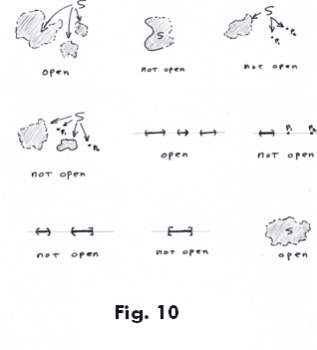
Def. Isolated point. A point of a point set in whose neighborhood there is no other point of the set.
If a point P in a set S is not a limit point then it is an isolated point. In Fig. 8 points P4 and P5 are isolated points.
Def. Open set. A point set is said to be open if each of its points is an interior point.
Example. Figure 10 contains various sets. Some are open, some not, as indicated.
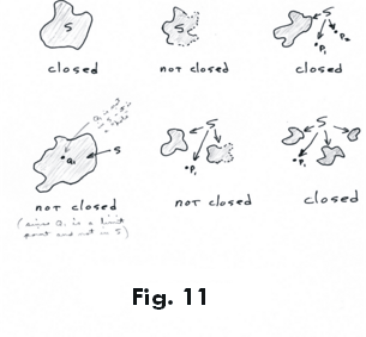
Def. Closed set. A point set is called closed if it contains all of it limit points.
Example. Figure 11 contains various sets. Some are closed, some not, as indicated.
In general, a point set may be open, closed and neither open nor closed.
Def. Closure of a set. The
closure
![]() of a point set S consists
of S together with all its limit
points i.e.
of a point set S consists
of S together with all its limit
points i.e.
![]() .
.
Example. Figure 12 shows some sets and their closures.
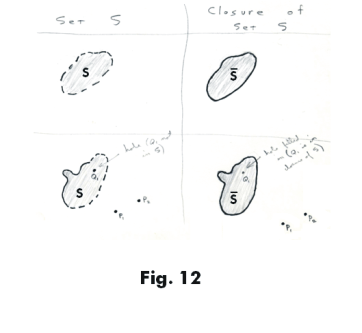
Def. Perfect set. A set is S called perfect if every point of S is a limit point i.e. if S is identical with its derived set S'.
A closed set is perfect if it has no isolated points.
Def. Arcwise connected set. A point set such that each pair of its points can be joined by a curve all of whose points are in the set.
Examples. The sets in figures 2 and 3 are arcwise connected. The sets in figures 4 and 7 are not.
Def. Region. A set that is the union of an open connected set and none, some, or all of its boundary points. The set is an open region if none of the boundary is included; it is a closed region if all of the boundary is included
Syn. Domain
Examples. A closed triangular region (or triangular region) is a triangle together with its interior. A closed circular region (or circular region) is a circle together with its interior; a closed rectangular region (or rectangular region) is a rectangle together with its interior. The interior of a triangle, circle, or rectangle is an open triangular region, an open circular region, and an open rectangular region, respectively. The interior of a sphere is an open region, and the sphere together with its interior is a closed region.
James/ James. Mathematics Dictionary. “Region”.
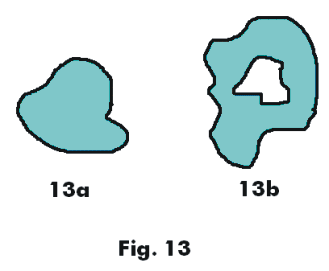
Def. Simply connected region. A region R is said to be simply connected if every closed curve in R can be continuously shrunk to a point in R without leaving R. If a region is not simply connected it is said to be multiply connected.
Examples. The region shown in Fig. 13a is simply connected and the region of Fig.13b is multiply connected.
Def. Open Covering of a Set. A class C of open intervals is said to be an open covering
of a set S if every point of S belongs to some member of C. If a set Q
![]() C is an open covering
of S, Q is called an open subcovering of S.
C is an open covering
of S, Q is called an open subcovering of S.
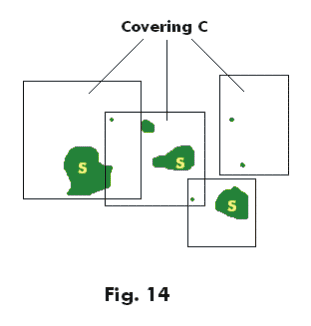
Example. See Fig. 14.
Def. Bounded set of points. A set of points for which the set of distances between pairs of points is a bounded set.
Theorems on point sets
1. The complement of an open set is closed and the complement of a closed set is open.
2. The union of any number of open sets is open and the intersection of a finite number of open sets in open.
3. The union of a finite number of closed sets is closed and the intersection of any number of closed sets is closed.
4. Every open interval on the real line can be expressed as a countable union of disjoint open intervals (called component intervals) unique except as to the order of the intervals.
Weierstrass-Bolzano theorem. Every bounded infinite set in R has at least one limit point or accumulation point.
Heine-Borel theorem. Every open covering of a closed and bounded point set S contains a finite open subcovering (i.e. S is covered by a finite number of open intervals).
Note. For Euclidean n-dimensional spaces the Heine-Borel theorem is equivalent to the Weirstrass-Bolzano theorem.
Def. Compact set. A set S is called compact if every open covering of S has a finite subcovering. For Eucledian n-space, compact is equivalent to closed and bounded.
References
James and James. Mathematics Dictionary
Spiegel. Complex Variables (Schaum)
Spiegel. Real Variables (Schaum)
Mathematics, Its Content, Methods and Meaning. Vol. III
Jesus Christ and His Teachings
Way of enlightenment, wisdom, and understanding
America, a corrupt, depraved, shameless country
On integrity and the lack of it
The test of a person's Christianity is what he is
Ninety five percent of the problems that most people have come from personal foolishness
Liberalism, socialism and the modern welfare state
The desire to harm, a motivation for conduct
On Self-sufficient Country Living, Homesteading
Topically Arranged Proverbs, Precepts, Quotations. Common Sayings. Poor Richard's Almanac.
Theory on the Formation of Character
People are like radio tuners --- they pick out and listen to one wavelength and ignore the rest
Cause of Character Traits --- According to Aristotle
We are what we eat --- living under the discipline of a diet
Avoiding problems and trouble in life
Role of habit in formation of character
Personal attributes of the true Christian
What determines a person's character?
Love of God and love of virtue are closely united
Intellectual disparities among people and the power in good habits
Tools of Satan. Tactics and Tricks used by the Devil.
The Natural Way -- The Unnatural Way
Wisdom, Reason and Virtue are closely related
Knowledge is one thing, wisdom is another
My views on Christianity in America
The most important thing in life is understanding
We are all examples --- for good or for bad
Television --- spiritual poison
The Prime Mover that decides "What We Are"
Where do our outlooks, attitudes and values come from?
Sin is serious business. The punishment for it is real. Hell is real.
Self-imposed discipline and regimentation
Achieving happiness in life --- a matter of the right strategies
Self-control, self-restraint, self-discipline basic to so much in life